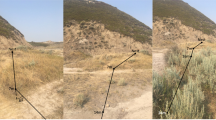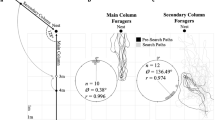Abstract
Foragers of many ant species use pheromone trails to guide nestmates to food sources. During foraging, individual workers can also learn the route to a food source. Foragers of the mass-recruiting ant Lasius niger use both pheromone trails and memory to locate a food source. As a result, an experienced forager can have a conflict between social information (trail pheromones) and private information (route memory) at trail bifurcations. We tested decision making in L. niger foragers facing such an informational conflict in situations where both the strength of the pheromone trail and the number of previous visits to the food source varied. Foragers quickly learned the branch at a T bifurcation that leads to a food source, with 74.6% choosing correctly after one previous visit and 95.3% after three visits. Pheromone trails had a weaker effect on choice behaviour of naïve ants, with only 61.6% and 70.2% choosing the branch that had been marked by one or 20 foragers versus an unmarked branch. When there was a conflict between private and social information, memory overrides pheromone after just one previous visit to a food source. Most ants, 82–100%, chose the branch where they had collected food during previous foraging trips, with the proportion depending on the number of previous trips (1 v. 3) but not on the strength of the pheromone trail (1 v. 20). In addition, the presence of a pheromone trail at one branch in a bifurcation had no effect on the time it took an experienced ant to choose the correct branch (the branch without pheromone). These results suggest that private information (navigational memory) dominates over social information (chemical tail) in orientation decisions during foraging activities in experienced L. niger foragers.




Similar content being viewed by others
References
Aron S, Beckers R, Deneubourg JL, Pasteels JM (1993) Memory and chemical communication in the orientation of two mass-recruiting ant species. Insectes Soc 40:369–380
Barth FG, Hrncir M, Jarau S (2008) Signals and cues in the recruitment behavior of stingless bees (Meliponini). J Comp Physiol A 194:313–327
Bates D (2007) lme4: Linear mixed-effects models using S4 classes. R package version 0.99875-7.
Beckers R, Goss S, Deneubourg JL, Pasteels JM (1989) Colony size, communication and ant foraging strategy. Psyche 96:239–256
Beckers R, Deneubourg JL, Goss S, Pasteels JM (1990) Collective decision making through food recruitment. Insectes Soc 37:258–267
Beckers R, Deneubourg JL, Goss S (1992) Trail laying behaviour during food recruitment in the ant Lasius niger (L.). Insectes Soc 39:59–72
Beckers R, Deneubourg JL, Goss S (1993) Modulation of trail laying in the ant Lasius niger (Hymenoptera: Formicidae) and its role in the collective selection of a food source. J Insect Behav 6:751–759
Beverly BD, McLendon H, Nacu S, Holmes S, Gordon DM (2009) How site fidelity leads to individual differences in the foraging activity of harvester ants. Behav Ecol 20:633–638
Bolker BM, Brooks ME, Clark CJ, Geange SW, Poulsen JR, Stevens MHH, White JS (2009) Generalized linear mixed models: a practical guide for ecology and evolution. TREE 24:127–135
Carroll CR, Janzen DH (1973) Ecology of foraging by ants. Annu Rev Ecol Syst 4:231–257
Collett TS, Collett M (2002) Memory use in insect visual navigation. Nat Rev Neurosci 3:542–552
Collett TS, Graham P, Durier V (2003) Route learning by insects. Curr Opin Neurobiol 13:718–725
Deneubourg JL, Pasteels JM, Verhaeghe JC (1983) Probabilistic behaviour in ants: a strategy of errors? J Theor Biol 105:259–271
Detrain C, Deneubourg JL (2008) Collective decision-making and foraging patterns in ants and honeybees. Adv Insect Physiol 35:123–173
Devigne C, Detrain C (2002) Collective exploration and area marking in the ant Lasius niger. Insectes Soc 49:357–362
Dussutour A, Deneubourg JL, Fourcassié V (2005) Temporal organization of bi-directional traffic in the ant Lasius niger (L.). J Exp Biol 208:2903–2912
Evison SEF, Petchey OL, Beckerman AP, Ratnieks FLW (2008) Combined use of pheromone trails and visual landmarks by the common garden ant Lasius niger. Behav Ecol Sociobiol 63:261–267
Grüter C, Farina WM (2009) The honeybee waggle dance: can we follow the steps? TREE 24:242–247
Grüter C, Balbuena MS, Farina WM (2008) Informational conflicts created by the waggle dance. Proc R Soc B 275:1321–1327
Hangartner W (1967) Spezifität und Inaktivierung des Spurpheromons von Lasius fuliginosus Latr. Und Orientierung der Arbeiterinnen im Duftfeld. Z vergl Physiol 57:103–136
Harrison JF, Fewell JH, Stiller TM, Breed MD (1989) Effects of experience on use of orientation cues in the giant tropical ant. Anim Behav 37:869–871
Hölldobler B (1976) Recruitment behavior, home range orientation and territoriality in harvester ants, Pogonomyrmex. Behav Ecol Sociobiol 1:3–44
Hölldobler B (1995) The chemistry of social regulation: multicomponent signals in ant societies. PNAS 92:19–22
Hölldobler B (1999) Multimodal signals in ant communication. J Comp Physiol A 184:129–141
Hölldobler B, Wilson EO (1990) The ants. The Belknap Press of Harvard University, Cambridge
Jackson DE, Ratnieks FLW (2006) Communication in ants. Curr Biol 16:R570–R574
Jarau S (2009) Chemical communication during food exploitation in stingless bees. In: Jarau S, Hrncir M (eds) Food Exploitation by social insects: ecological, behavioral, and theoretical approaches. CRC University Press, Taylor and Francis Group, Boca Raton
Jarau S, Hrncir M (2009) Food exploitation by social insects: ecological, behavioral, and theoretical approaches. CRC University Press, Taylor and Francis Group, Boca Raton
Jeanson R, Ratnieks FLW, Deneubourg JL (2003) Pheromone trail decay rates on different substrates in the Pharao’s ant, Monomorium pharaonis. Physiol Entomol 28:192–198
Kendal RL, Coolen I, van Bergen Y, Laland KN (2005) Trade-offs in the adaptive use of social and asocial learning. Adv Stud Behav 35:333–379
Laland KN (2004) Social learning strategies. Learn Behav 32:4–14
Le Breton J, Fourcassié V (2004) Information transfer during recruitment in the ant Lasius niger L. (Hymenoptera: Formicidae). Behav Ecol Sociobiol 55:242–250
Leadbeater E, Chittka L (2007) Social learning in insects—from miniature brains to consensus building. Curr Biol 17:R703–R713
Leadbeater E, Chittka L (2009) Bumble-bees learn the value of social cues through experience. Biol Letters 5:310–312
Lindauer M, Kerr WE (1960) Communication between the workers of stingless bees. Bee World 41:29–71
Mailleux AC, Detrain C, Deneubourg JL (2005) Triggering and persistence of trail-laying in foragers of the ant Lasius niger. J Insect Physiol 51:297–304
Quinet Y, Pasteels JM (1996) Spatial specialization of the foragers and foraging strategy in Lasius fuliginosus (Latreille) (Hymenoptera, Formicidae). Insectes Soc 43:333–346
Ratnieks FLW (2008) Biomimicry: further insights from ant colonies? In: Liò P, Yoneki E, Crowcroft J, Verma DC (eds) Bio-inspired computing and communication. Springer, Berlin, pp 50–58
R Development Core Team (2009) R: A language and environment for statistical computing. R Foundation for Statistical Computing, Vienna
Ribbands CR (1949) The foraging method of individual honey-bees. J Anim Ecol 18:47–66
Robinson EJH, Jackson DE, Holcombe M, Ratnieks FLW (2005) ‘No entry’ signal in ant foraging. Nature 438:442
Rosengren R, Fortelius W (1986) Ortstreue in foraging ants of the Formica rufa group—hierarchy of orienting cues and long-term memory. Insectes Soc 33:306–337
Salo O, Rosengren R (2001) Memory of location and site recognition in the Ant Formica uralensis (Hymenoptera: Formicidae). Ethology 107:737–752
Seppänen JT, Forsman JT, Mönkkönen M, Thomson RL (2007) Social information use is a process across time, space, and ecology, reaching heterospecifics. Ecology 88:1622–1633
Traniello JFA (1977) Recruitment behavior, orientation, and the organization of foraging in the carpenter ant Camponotus pennsylvanicus DeGeer (Hymenoptera: Formicidae). Behav Ecol Sociobiol 2:61–79
Traniello JFA (1980) Colony specificity in the trail pheromone of an ant. Naturwissenschaften 67:361–362
Völkl W, Woodring J, Fischer M, Lorenz MW, Hoffmann KH (1999) Ant-aphid mutualisms: the impact of honeydew production and honeydew sugar composition on ant preferences. Oecologia 118:483–491
von Frisch K (1923) Über die Sprache der Bienen. Zool Jb Physiol 40:1–186
von Frisch K (1967) The dance language and orientation of bees. Harvard University Press, Cambridge
Wilson EO (1971) The insect societies. Harvard University Press, Cambridge
Zuur AF, Ieno EN, Walker NJ, Saveliev AA, Smith GM (2009) Mixed effects models and extensions in ecology with R. Springer, New York, p 574
Acknowledgements
We thank Thomas Durance and Lucy Taylor for help with data collection. C.G. was supported by a postdoctoral fellowship from the Swiss National Science Foundation (SNSF grant PBBEP3-123648). T.C. was supported by a PhD studentship from the BBSRC.
Ethical standards
The experiments comply with the current laws of the country in which they were performed.
Conflicts of interest
The authors declare that they have no conflict of interest.
Author information
Authors and Affiliations
Corresponding author
Additional information
Communicated by J. Traniello
Rights and permissions
About this article
Cite this article
Grüter, C., Czaczkes, T.J. & Ratnieks, F.L.W. Decision making in ant foragers (Lasius niger) facing conflicting private and social information. Behav Ecol Sociobiol 65, 141–148 (2011). https://doi.org/10.1007/s00265-010-1020-2
Received:
Revised:
Accepted:
Published:
Issue Date:
DOI: https://doi.org/10.1007/s00265-010-1020-2




